A Grade Crossing on the Cheap
Cardstock, spray paint, some strip wood glue and chalks were all that was used. About mid-way along the 34’ side of the Baltimore & New York Railway there is a branch that comes off the west mainline track. This is Rossiter Junction, with a small station and a tower.
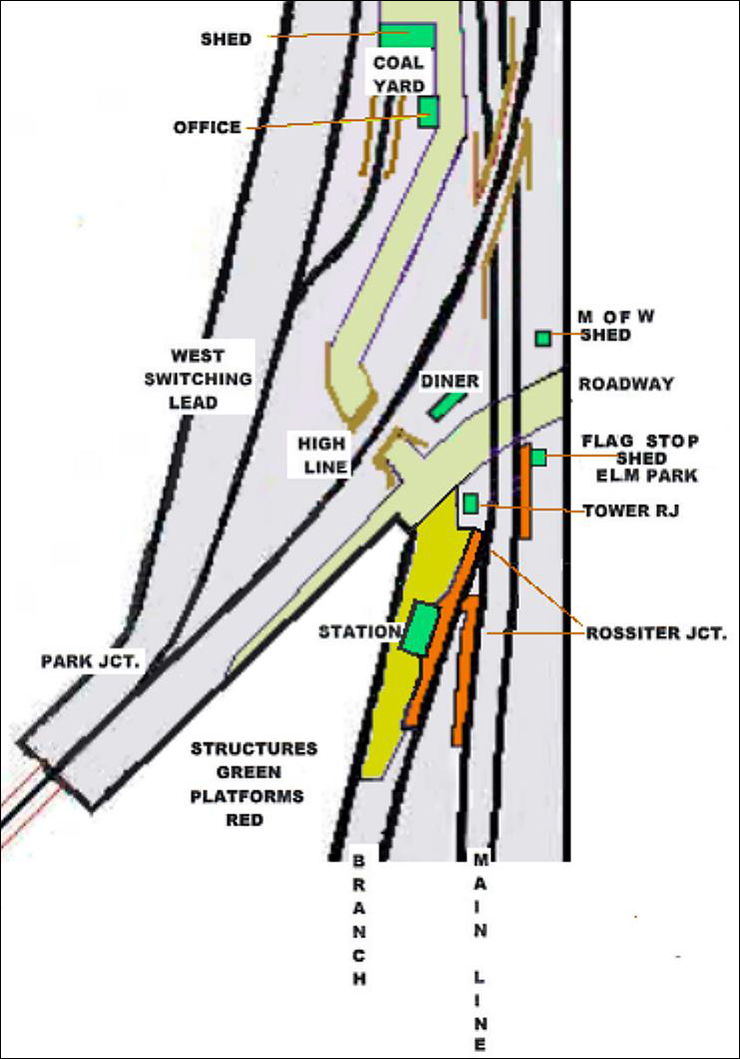 Track Map for the grade crossing area.
Track Map for the grade crossing area.
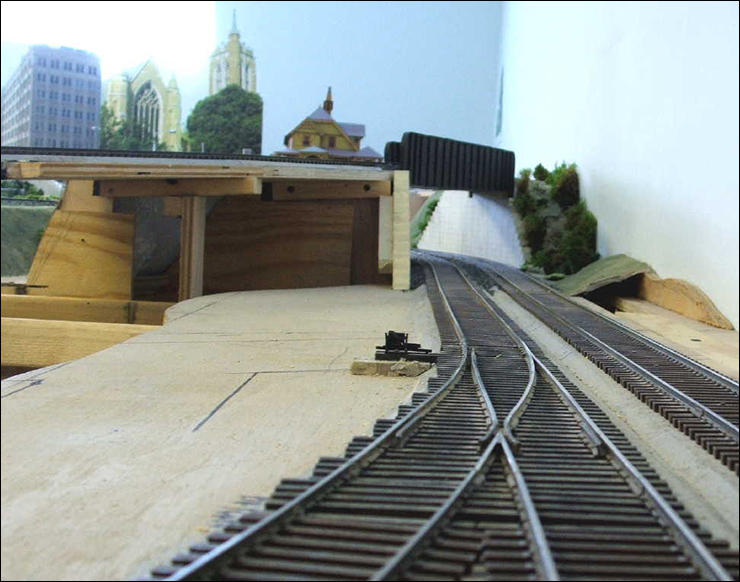 Location of the grade crossing on the Baltimore & New York layout, under construction in 2006.
Location of the grade crossing on the Baltimore & New York layout, under construction in 2006.
Yet space at the junction lacked something. There is narrow road mapped, going back to the coal yard and its dump trestle needing some outside connection. Space was tight as well, since that area is inset on the layout to more easily reach the track work
A road could cut across the two mainline tracks here at a slight angle near the junction. Rossiter Junction station has a parking lot and brick platform, giving it a suburban flavor. So the grade crossing was expanded from a narrow road to State Highway 5, with two 10’ wide lanes. Since the B&O is the parent here, company drawings of 1945 for a bituminous concrete grade crossing were used.
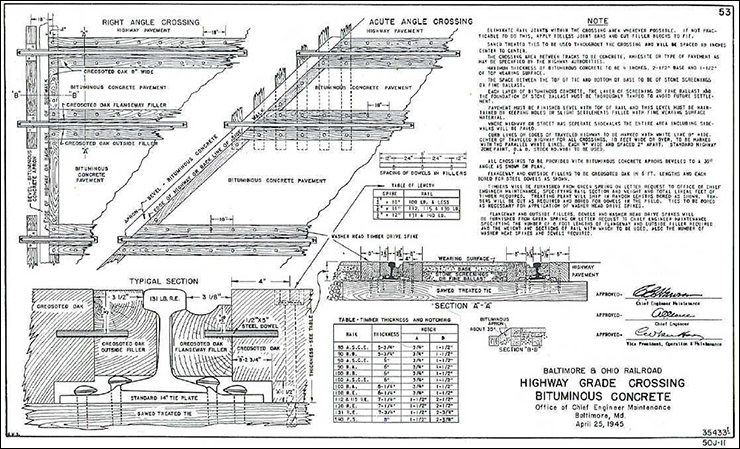 A 1945 B&O drawing for a bituminous concrete grade crossing. This type was being used as replacements for older wood decked crossings in the course of maintaining and upgrading track work on all divisions.
A 1945 B&O drawing for a bituminous concrete grade crossing. This type was being used as replacements for older wood decked crossings in the course of maintaining and upgrading track work on all divisions.
First, the layout needed a base for the main road. A paper pattern was cut and fitted into the space where it would be located: 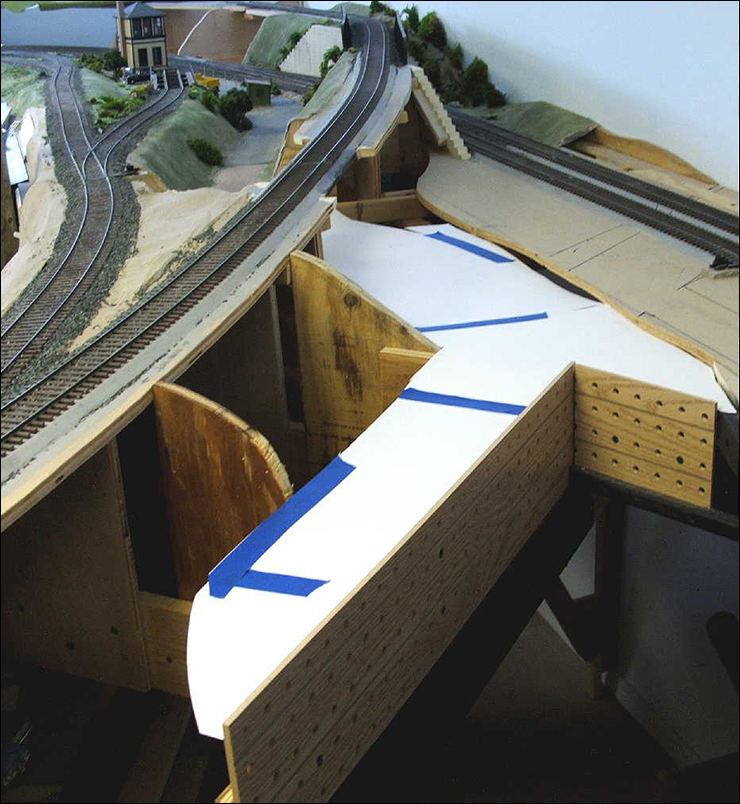
Next, a plywood base was cut fitted and attached to the bench work. 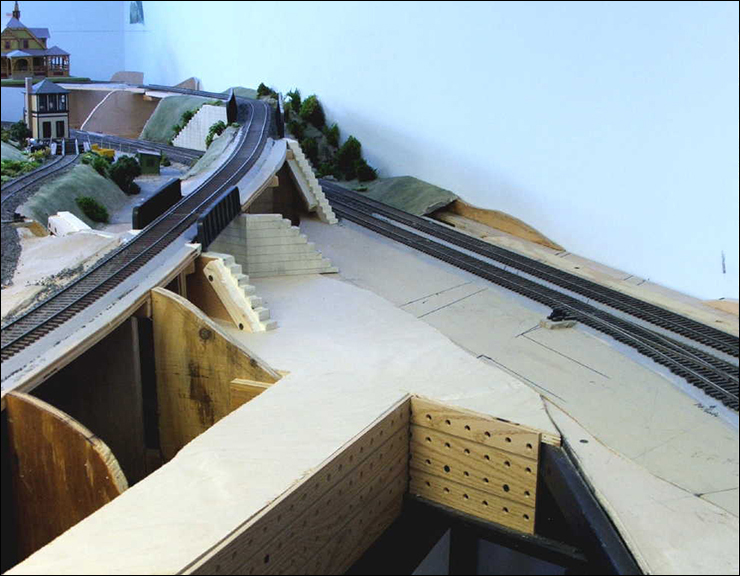
Then a layer of Homasote to bring the roadbed close to track height: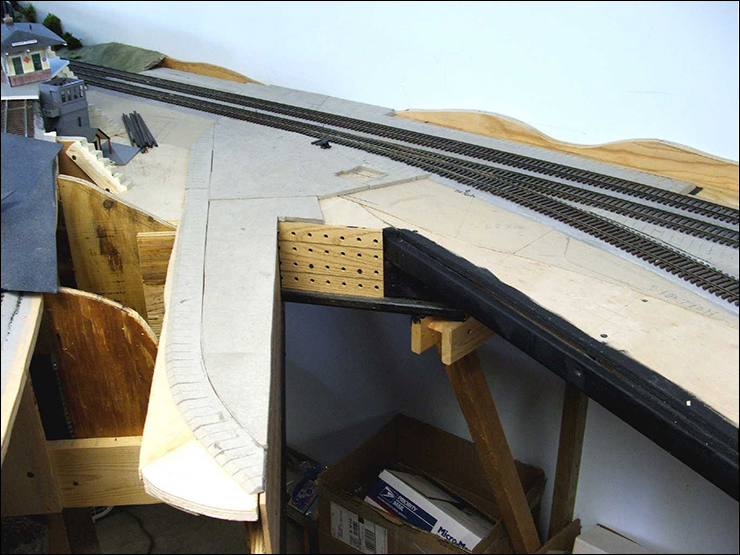 The square cut out in the Homasote is for the tower that will be located at this crossing and junction. Other work was also done at the same time in detailing and finishing the scene for this junction.
The square cut out in the Homasote is for the tower that will be located at this crossing and junction. Other work was also done at the same time in detailing and finishing the scene for this junction.
Last, the main road was cut out of 1/16” thick black illustration board and temporarily fitted in place. Once trimmed to an exact fit, it was sprayed with a coat of Rustoleum black high heat resisting texture paint (used for painting refinishing out door grills). It provides a Macadam like finish.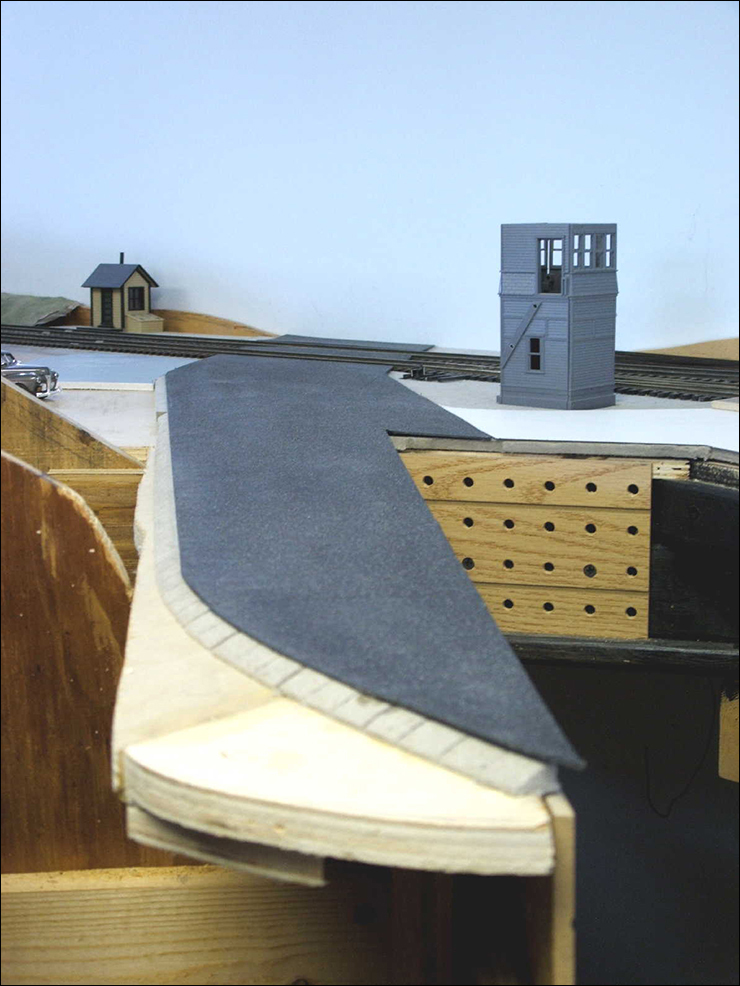
To build up the roadway to just below rail head height, it was shimmed with additional layers of illustration board for a gradual rise. Sections of illustration board were cut to fit between the rails, allowing for the wheel flange gaps as well as the wood edging. These parts were also shimmed to be close rail head height when resting on the ties.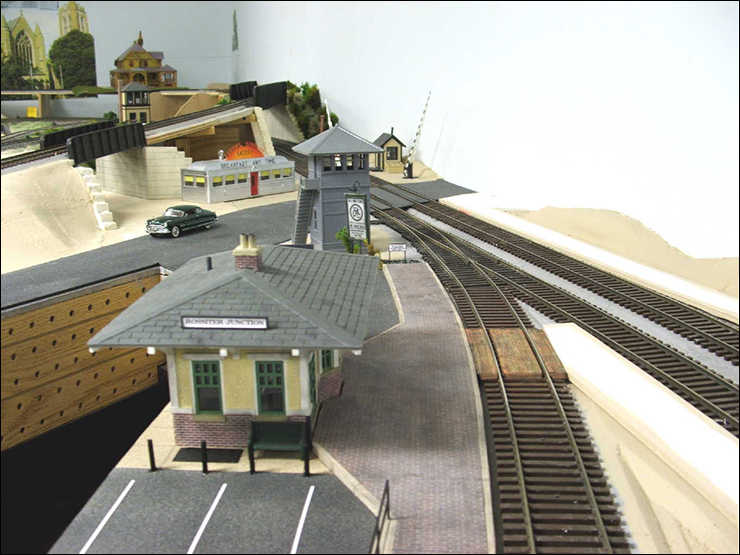 Work was also being done to site the worked over Plasticville station for the junction.
Work was also being done to site the worked over Plasticville station for the junction.
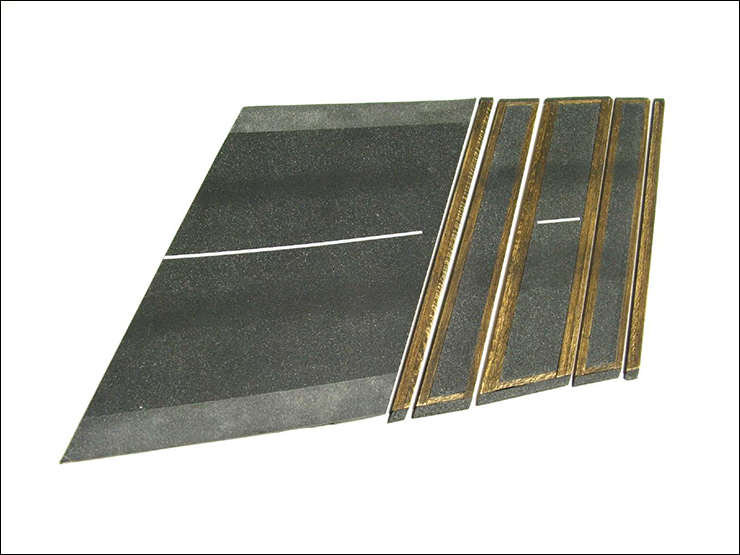 1/8” x 1/8” pre-stained strip wood was used for the edging. To fit properly, one corner needs to be cut back by carving, using a shaper or a small plane. The wood must fit close to outer sides of the rails and also clear the tie plates and spikes underneath It is then trimmed to length and glued to the edge of the road way. The wood edging for inside the rails needs less trimming. They need only enough trimming to allow for the flange ways when placed on the ties.
1/8” x 1/8” pre-stained strip wood was used for the edging. To fit properly, one corner needs to be cut back by carving, using a shaper or a small plane. The wood must fit close to outer sides of the rails and also clear the tie plates and spikes underneath It is then trimmed to length and glued to the edge of the road way. The wood edging for inside the rails needs less trimming. They need only enough trimming to allow for the flange ways when placed on the ties.
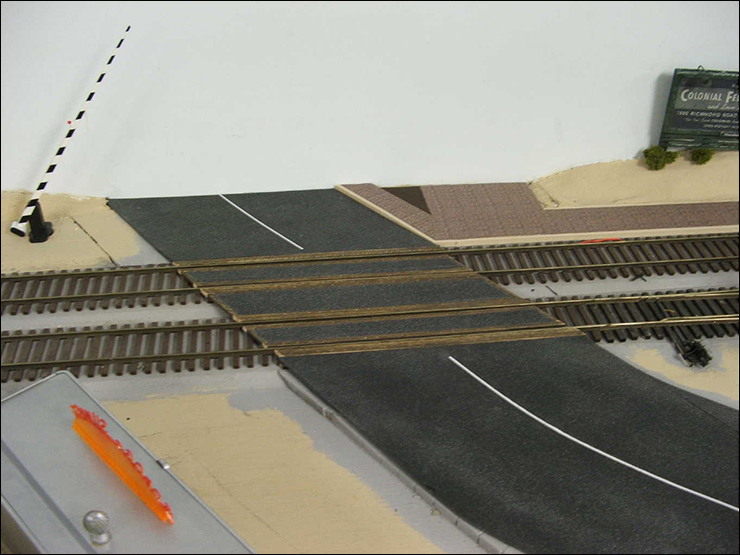 Making the roadway track inserts to fit properly is a bit tricky. The black illustration board pavement inserts were made slightly oversized and sprayed with the Rustoleum texture paint. The wood edging close to the rail head was fitted first. The part was then trimmed so the wood edging for the flange way would fit correctly. This was done for both track inserts as well as the short piece of pavement between the two tracks. Once they fitted properly between the rails, the ends were trimmed and fitted with wood edging as well as an angled berm also made of wood, then brush painted with the Rustoleum texture paint that had been sprayed on a piece of scrap cardstock.
Making the roadway track inserts to fit properly is a bit tricky. The black illustration board pavement inserts were made slightly oversized and sprayed with the Rustoleum texture paint. The wood edging close to the rail head was fitted first. The part was then trimmed so the wood edging for the flange way would fit correctly. This was done for both track inserts as well as the short piece of pavement between the two tracks. Once they fitted properly between the rails, the ends were trimmed and fitted with wood edging as well as an angled berm also made of wood, then brush painted with the Rustoleum texture paint that had been sprayed on a piece of scrap cardstock.
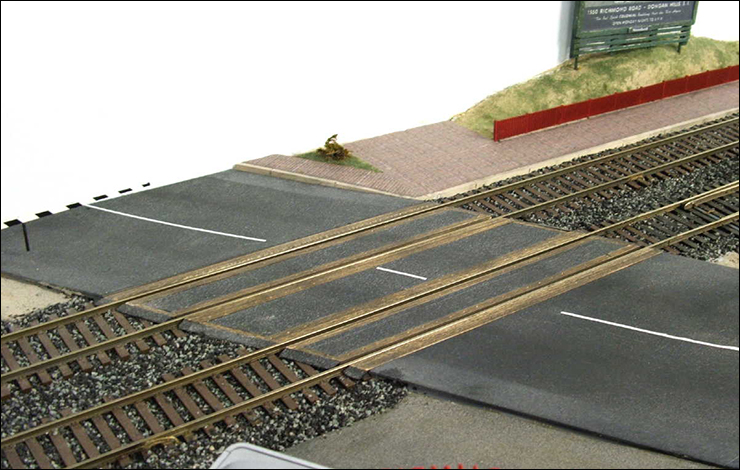 Weathering for the road surface was done by brushing gray and black chalks into the Rustoleum. A shoulder was added by masking off the main road, and applying a liberal layer of gray chalk dust and working into the surface. Remove the tape and there is a lighter colored shoulder along the roadway. The centerline is white chart tape. Once all is glued in place and ballast added, the crossing is complete.
Weathering for the road surface was done by brushing gray and black chalks into the Rustoleum. A shoulder was added by masking off the main road, and applying a liberal layer of gray chalk dust and working into the surface. Remove the tape and there is a lighter colored shoulder along the roadway. The centerline is white chart tape. Once all is glued in place and ballast added, the crossing is complete.
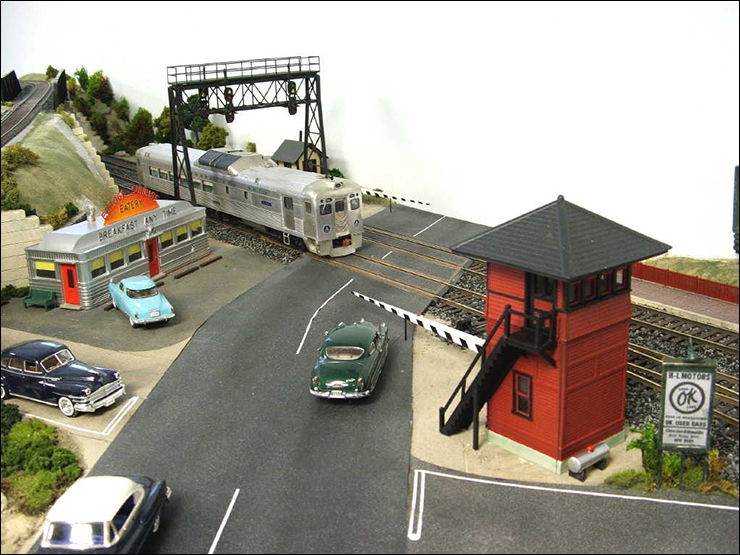 At the finished grade crossing, a west bound B&O ”Speedliner” RDC-2 slows on its way across Highway 5, for a stop at Rossiter Junction.
At the finished grade crossing, a west bound B&O ”Speedliner” RDC-2 slows on its way across Highway 5, for a stop at Rossiter Junction.